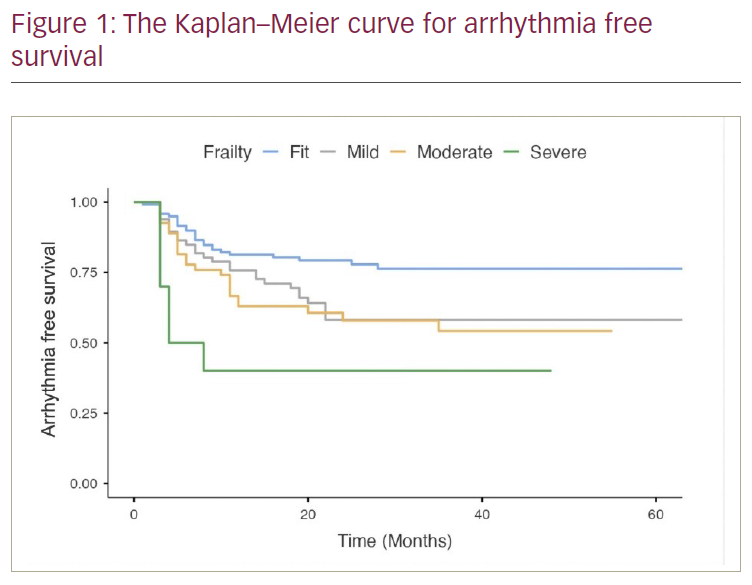Background: Catheter ablation for atrial fibrillation (AF) has been shown to reduce symptoms and improve quality of life when compared with medical treatment. It is unclear whether frailty impacts on the outcome of pulmonary vein isolation in patients with symptomatic AF. We sought to evaluate the association between frailty as measured by the validated NHS electronic Frailty Index (eFI) and outcomes of AF ablation.
Methods: All patients who had undergone second-generation cryoablation between January 2015 and May 2019 and aged ≥65 at Eastbourne District General Hospital were included in the study retrospectively. The primary endpoint for success was defined as freedom from atrial arrhythmia lasting >30 seconds during the follow-up period beyond the 3-month blanking period. Frailty was based on the eFI and the cohort split into four groups: fit, mild, moderate and severe frailty. Baseline continuous variables were compared using one-way ANOVA between groups and time to arrhythmia between groups was compared using the log rank test.
Results: The study included 248 patients with a mean age of 72.9 ± 5.16 years and a mean follow-up of 25.8 ± 17.3 months. 52.8% of patients were female. Frailty was categorised as fit (118/248; 47.6%), mild (66/248; 26.6%), moderate (54/248; 21.8%), and severe (10/248; 4.0%). There was no significant difference in age between the groups (p=0.132). Patients with severe frailty had a significantly longer duration of AF pre-ablation than patients who were fit (p=0.005) or who had mild frailty (p=0.038).
Freedom from arrhythmia occurred in 167 of 248 patients (67.3%). Fit patients had a significantly greater freedom from arrhythmia (92/118; 78.0%) compared with patients with mild frailty (40/66; 60.6%, p=0.020), moderate frailty (31/54; 57.4%, p=0.006) or severe frailty (4/10; 40.0%, p<0.001). (Figure 1) There was also a significant difference in arrythmia occurrence between patients with mild frailty and severe frailty (p=0.044).
Conclusion: Frailty is associated with poorer outcomes in patients undergoing AF ablation. The eFI may be used in the prognostic evaluation of AF ablation outcomes. Further studies are essential to confirm the findings of this study. ❑








